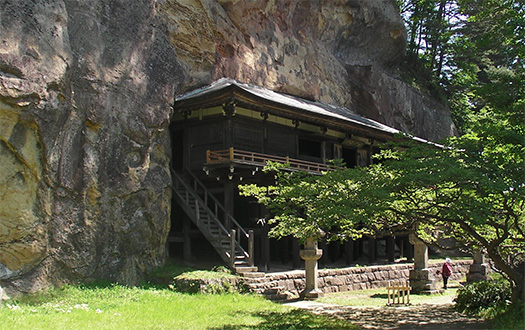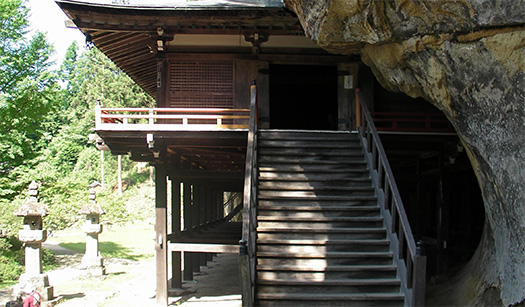

先日紹介した「達谷の窟」続篇であります。
日本の仏教美術のひとつの傾向として、岩をくり抜いたなかに仏が出現するという
そういったいわば自然由来系が多いように思う。
あらゆる場所に神宿るというような心性が日本人好みなのだろうか。
ふとした場所に神性が示現するという精神性が強い。
こういう好みが、円空の「一木彫り」のような極限的感性を生んだ。
たぶん、八百万の神々という在地宗教心が基盤ではないか。
東アジア世界で律令国家が成立していくなかで日本ではヤマト政権、
天皇を中心とした支配体制が自己の権力を正当化するのに、
仏教による「鎮護国家」思想を民の救済として広範に広めた。
大陸的国家の場合、暴力的独裁制が優先する権力構造になりやすいが、
島嶼国家で、他民族からの侵略経験が少ないことが関係しているのか。
全国に「国分寺」「国分尼寺」をあまねく建設するという途方もない政策が
実際に行われ、中国でも朝鮮でも仏教はやがて衰退したのに
ひとり日本だけは仏教が民に根付いていくことになった。
結果として民衆の救済として仏教思想が根付いていったのだと思う。
中国国家は易姓革命による絶対王権であり、独裁が基本権力性格。
そういう権力の場合、宗教に対して中立性がなく、常に過剰な傾斜と
過剰な弾圧という振り子の激しさから逃れられない。いわば独裁の恣意。
現に文革時代にも寺院が破却され続け、再建には日本の支援が与っている。
仏教はそうした振り子に翻弄されてきたのがかの国での現実。
鑑真が失明の苦難を冒しても日本に伝道のためにやって来たのは、
そのような中国国家の危うさを見抜き、まだしも東方海上の青年国家に
仏教の涅槃を夢見た部分もあったのだと思う。
そして実際に日本は独裁ではなく、天皇神聖権力と施政権力とが分離し、
宗教にとって非常にいごこちのいい国家社会環境が熟成していったのだと思う。
島嶼国家であることが、そのような平和な環境を醸成したのか、
あるいは日本人の民族性、DNA自体に独裁を嫌う心性が強いのか。
そういった仏教思想の発露として、東北地域は独特だとも思える。
この坂上田村麻呂による征夷以降、奥州藤原氏の覇権が成立したときにも
独特の仏教思想による救済が強く念願され、そのための宗教施設が
京の都を凌駕するようなカタチで仏国土として建築されていった。
石器時代〜縄文時代由来の自然崇拝系の民の末裔として
アテルイというヤマト王権への反逆者の「怨霊」沈静化の意図で
こうした窟への寺院宗教建築の「継ぎ足し」という建築思想を当てたのは、
まことに日本的・融和的考え方だと思う。
窟に込められた古代的呪術性に理性的な仏教的加護を加えて鎮魂する。
鬼とされたアテルイにしても、こうまで鎮魂されれば矛を納めざるを得なかったか。
残念ながら毘沙門堂内部撮影は不許可ということ。
創建時の怨霊鎮魂意図からすればやむを得ないと思うのですが、
なんと、堂内では自然の窟が荒々しい表情そのまま岩面を表している。
それがみごとな寺院建築で被覆され、一種神々しい自然融合建築を垣間見せる。
建築としては自然との繋ぎの部分がどう処理されたのか、
その匠の技に強く惹かれるけれど、詳細はまだ調査できておりません。
ただ、古来の建築技法に「懸造」という技法がありその実践例とされている。
先日この建築について書いたとき、ある方から
ぜひこの窟建築をもっとアピールして欲しいというリクエストもありました。
もしこの建築が京都や大阪、あるいは東京などに存在していたら、
清水寺などを遙かに凌駕する世界建築と認定されたことは疑いがありません。
English version⬇
[Takkoku Saikoji, the divinity of architecture that unites with nature]
This is the sequel to “Takkoku Saikoji” introduced the other day.
One of the trends in Japanese Buddhist art is that Buddha appears in the hollowed out rocks.
I think there are many naturally derived systems.
I wonder if Japanese people like the spirit of staying in God everywhere.
There is a strong spirituality that divinity manifests in a casual place.
This kind of taste gave birth to an extreme sensibility like Enku’s “one-wood carving.”
Perhaps it is based on the local religious spirit of eight million gods.
While the Ritsuryo nation was established in the East Asian world, the Yamato administration in Japan,
Even though the rule system centered on the emperor justifies his power
The Buddhist idea of a “guardian state” was widely disseminated as a salvation for the people.
In the case of continental nations, violent dictatorship tends to be a priority power structure,
Is it related to the fact that the island nation has little experience of invasion by other ethnic groups?
There is a tremendous policy to build “Kokubunji” and “Kokubunnanji” all over the country.
It was actually done, and Buddhism eventually declined in both China and Korea.
Only in Japan, Buddhism has taken root in the people.
As a result, I think that Buddhist thought has taken root as a relief for the people.
The Chinese state is an absolute monarchy due to the easy surname revolution, and dictatorship is the basic power character.
In the case of such power, there is no religion neutrality, and there is always an excessive inclination.
I cannot escape from the intensity of the pendulum, which is excessive repression. So to speak, dictatorship.
In fact, the temple continued to be destroyed during the Cultural Revolution, and Japan’s support is provided for its reconstruction.
The reality of Buddhism in that country has been tossed by such a pendulum.
Even though Jianzhen suffered from blindness, he came to Japan for evangelism.
Seeing the danger of such a Chinese nation, it is still a youth nation on the eastern sea
I think there was a part where I dreamed of Buddhist nirvana.
And in fact, Japan is not a dictatorship, but the sacred power of the emperor and the administration power are separated.
I think that the national social environment, which is very comfortable for religion, has matured.
Did the island nation foster such a peaceful environment?
Or is the Japanese ethnicity and DNA itself strongly disliked dictatorship?
The Tohoku region seems to be unique as a manifestation of such Buddhist ideas.
Even when Mr. Fujiwara Oshu’s hegemony was established after the conquest by Sakanoue Tamura Maro
A strong desire for relief based on a unique Buddhist idea, and a religious facility for that purpose
It was built as a French land with a shape that surpasses the capital of Kyoto.
As a descendant of nature worshipers from the Stone Age to the Jomon period
With the intention of calming the “grudge” of the rebels against the Yamato kingdom called Aterui
It was the architectural idea of ”addition” of temple religious architecture to these caves.
I think it’s a Japanese and harmonious way of thinking.
Requiescats by adding rational Buddhist blessing to the ancient magical nature of the cave.
Even Aterui, who was regarded as a demon, had to pay a halberd if he was requiescated so far.
Unfortunately, photography inside Bishamon-do is not permitted.
I think it is unavoidable from the intention of requiescats the ghost at the time of its foundation.
In the hall, the natural cave shows the rock surface as it is with a rough expression.
It is covered with a magnificent temple architecture, giving a glimpse of a kind of divine natural fusion architecture.
How was the connection with nature treated as an architecture?
I am strongly attracted to the craftsmanship, but I have not yet investigated the details.
However, there is a technique called “Kakezukuri” in the ancient building technique, which is regarded as a practical example.
When I wrote about this architecture the other day, from one person
There was also a request to make this cave architecture more appealing.
If this architecture exists in Kyoto, Osaka, Tokyo, etc.
There is no doubt that it has been certified as a world architecture that far surpasses Kiyomizu-dera and other places.
Posted on 12月 15th, 2020 by 三木 奎吾
Filed under: 住宅マーケティング, 日本社会・文化研究, 歴史探訪







コメントを投稿
「※誹謗中傷や、悪意のある書き込み、営利目的などのコメントを防ぐために、投稿された全てのコメントは一時的に保留されますのでご了承ください。」
You must be logged in to post a comment.